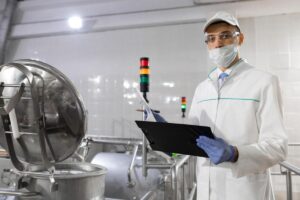What Is Food Safety Compliance and Why Does It Matter?

Food safety compliance is a systematic way of making sure food products are safe to eat from the moment they are made until they reach our plates. It includes a wide range of rules, standards, and practices aimed at protecting public health and preventing contamination.
Strict food safety protocols are crucial in preventing foodborne illnesses that affect millions of people worldwide every year. These measures create multiple barriers against potential hazards:
- Biological contaminants (such as bacteria and viruses)
- Chemical substances
- Physical objects
- Allergens
Having strong food safety standards compliance is essential for any business involved in handling, processing, or serving food. If these standards are not met, the consequences can be severe:
“A single food safety incident can destroy decades of brand building and consumer trust in minutes”
Food safety compliance is important because it:
- Protects Public Health – Prevents foodborne illnesses and potential fatalities
- Safeguards Businesses – Maintains operational licenses and prevents costly recalls
- Builds Consumer Trust – Shows commitment to quality and safety
- Ensures Legal Operation – Meets regulatory requirements and industry standards
With the rise of global food supply chains and increasing consumer awareness, food safety compliance has become more than just a basic requirement; it is now a crucial aspect of running a business. Modern compliance systems use technology, training, and thorough monitoring to ensure the highest safety standards are maintained.
Understanding Food Safety Compliance
Food safety compliance includes a set of rules, standards, and practices designed to protect public health by ensuring safe food handling and production. These requirements apply to every part of the food supply chain, from sourcing raw materials to delivering the final product.
Key Regulatory Bodies and Standards:
- FDA (Food and Drug Administration): Oversees food safety regulations in the United States, enforcing the Food Safety Modernization Act (FSMA)
- USDA (United States Department of Agriculture): Regulates meat, poultry, and egg products
- HACCP (Hazard Analysis Critical Control Points): International standard for systematic preventive approach to food safety
The main goals of food safety compliance are:
- Preventing biological contamination from harmful bacteria and viruses
- Eliminating physical hazards such as glass, metal, or plastic
- Controlling chemical hazards including pesticides and cleaning agents
- Maintaining proper temperature controls throughout storage and transport
- Implementing allergen control programmes
These requirements apply to various food industry sectors:
- Food manufacturing facilities
- Restaurant kitchens
- Food storage warehouses
- Transportation systems
- Retail establishments
Compliance standards require organisations to implement robust monitoring systems, maintain detailed documentation, and conduct regular staff training. These measures create multiple barriers against potential food safety hazards, establishing a comprehensive protection system for consumers.
Key Elements of Food Safety Compliance
Food safety compliance relies on several critical components working together to create a strong safety management system. These elements are the foundation of effective food safety protocols:
1. Hazard Analysis
- Systematic evaluation of biological, chemical, and physical risks
- Assessment of raw materials, ingredients, and processing methods
- Identification of potential contamination points throughout production
- Risk severity and likelihood calculations
2. Critical Control Points Management
- Strategic placement of control measures at high-risk areas
- Implementation of preventive steps at identified danger zones
- Regular validation of control point effectiveness
- Clear documentation of control parameters
3. Monitoring Systems and Critical Limits
- Establishment of measurable safety parameters
- Temperature controls for storage and cooking
- pH levels for fermented products
- Time limitations for food handling processes
4. Documentation and Corrective Actions
- Detailed record-keeping of all monitoring activities
- Real-time logging of safety measurements
- Immediate response protocols for safety breaches
- Root cause analysis of safety incidents
Modern food safety systems integrate these elements through digital platforms, enabling real-time monitoring and automated documentation. Advanced software solutions streamline the implementation of these crucial components, ensuring consistent compliance with food safety standards.
Best Practices for Ensuring Food Safety Compliance
Implementing robust food safety practices requires a systematic approach focused on prevention and control. Essential practices include:
Regulatory Compliance and Standards
- Regular review of current FDA, USDA, and local health department regulations
- Implementation of HACCP principles across operations
- Staff training on updated food safety protocols and certification requirements
- Periodic internal audits to verify compliance standards
- Adherence to the Safe Food for Canadians Regulations (SFCR), which set out requirements for food safety
Packaging Quality Control
- Selection of food-grade packaging materials meeting safety specifications
- Storage of packaging materials in clean, pest-free environments
- Regular testing of packaging integrity
- Implementation of tamper-evident seals and proper labelling
Supply Chain Traceability
- Detailed documentation of product movement from source to consumer
- Batch coding systems for precise product identification
- Supplier verification programme with documented food safety records
- Real-time inventory tracking systems
Equipment Hygiene Management
- Scheduled cleaning and sanitisation protocols
- Daily equipment inspection checklists
- Calibration of measurement devices
- Documented maintenance schedules
- Visual inspection standards for cleanliness verification
These practices create a strong foundation for maintaining food safety standards across operations. Digital compliance management systems streamline these processes through automated monitoring and documentation, reducing human error and ensuring consistent application of safety protocols.

Technological Solutions Enhancing Food Safety Compliance
Modern technology is changing the way food safety compliance is managed, making it more efficient and effective. Integrated digital solutions are at the forefront of this revolution.
Enterprise Resource Planning (ERP) Systems
ERP systems are centralised platforms that streamline various business processes, including food safety compliance. These systems offer a range of features that greatly benefit organisations in their quest for maintaining high standards of food safety. Here are some key advantages:
- Centralised Management: ERP systems serve as a single source of truth for all compliance data. This means that instead of relying on multiple spreadsheets or disconnected systems, organisations can manage everything from one place.
- Tracking Product Movement: With an ERP system in place, businesses can easily track the movement of their products throughout the supply chain. This visibility is crucial for ensuring that safety protocols are being followed at every stage.
- Detailed Records: Maintaining detailed records of safety protocols is essential for demonstrating compliance during audits or inspections. ERP systems make it easy to store and retrieve these records whenever needed.
Internet of Things (IoT) Sensors
IoT sensors play a vital role in enhancing food safety compliance by providing continuous monitoring of critical parameters. These sensors are devices that can collect and transmit data over the internet without human intervention. Here are some examples:
- Temperature Sensors: These sensors are installed in storage facilities to monitor and maintain optimal temperature conditions for perishable goods.
- Humidity Monitors: Processing areas where food is prepared or packaged require specific humidity levels to prevent spoilage or growth of harmful bacteria. Humidity monitors ensure that these levels are consistently maintained.
- pH Level Detectors: Certain food products have specific pH requirements for quality and safety purposes. pH level detectors help ensure that these requirements are met throughout the production process.
- Automated Cleaning Verification Systems: Cleaning procedures play a crucial role in preventing cross-contamination. Automated cleaning verification systems use sensors to confirm that cleaning tasks have been completed effectively.
Blockchain Technology
Blockchain technology has emerged as a powerful tool for enhancing transparency in the food supply chain. It creates an immutable record of each transaction and transfer point, making it nearly impossible to alter or manipulate data once it has been recorded.
Here are some key benefits of using blockchain technology in food safety compliance:
- Rapid Contamination Source Identification: In the event of a foodborne illness outbreak or contamination incident, blockchain enables quick identification of the source by tracing back through the supply chain.
- Product Authenticity Verification: With blockchain, consumers can verify the authenticity of products they purchase by accessing information about its origin and journey through the supply chain.
- Supplier Accountability Enhancement: By recording every transaction involving suppliers on the blockchain, businesses can hold their suppliers accountable for any lapses in quality or safety standards.
- Streamlined Recall Processes: In case a product needs to be recalled due to safety concerns, blockchain allows for targeted recalls by identifying specific batches or lots affected rather than recalling entire shipments.
Foreign Body Detection Technology
Foreign body contamination poses significant risks to consumer health and brand reputation. To mitigate this risk, various foreign body detection technologies have been developed:
X-ray Systems
X-ray systems use radiation to inspect products for foreign objects such as metal, glass, or stone. In addition to detecting these contaminants, they also assess product density and verify quality control measures.
Metal Detection
Metal detection technology identifies ferrous (iron-based) and non-ferrous metals within products during production or packaging processes. Automated rejection systems ensure that any contaminated items are removed from the production line before reaching consumers.
These foreign body detection technologies complement existing safety measures by providing an additional layer of protection against potential hazards.
Integration with Compliance Management Platforms
To maximise the effectiveness of these technological solutions, integration with compliance management platforms is crucial. Squizify is one such platform that offers comprehensive digital documentation and real-time alerts for potential safety breaches.
By integrating ERP systems, IoT sensors, blockchain technology, and foreign body detection technologies with Squizify’s compliance management platform:
- Businesses can streamline their documentation processes by automatically generating reports based on data collected from various sources.
- Real-time alerts can be triggered whenever there is a deviation from established safety protocols or guidelines.
- Advanced analytics capabilities provided by Squizify can help identify trends in non-compliance issues or potential risks before they escalate into major problems.
This holistic approach towards food safety compliance ensures that organisations stay proactive rather than reactive when it comes to managing risks associated with their operations.
Benefits of Food Safety Compliance
Food safety compliance delivers substantial advantages that extend far beyond basic regulatory requirements. These benefits create lasting value for businesses and stakeholders across the food industry.
1. Consumer Protection
- Rigorous safety protocols shield consumers from harmful contaminants
- Systematic prevention of foodborne illnesses through stringent controls
- Enhanced consumer trust through demonstrated commitment to safety
2. Brand Reputation Management
- Strong compliance records build credibility with customers
- Positive brand perception drives customer loyalty
- Public recognition as an industry leader in food safety
3. Cost-Effective Risk Management
- Proactive safety measures prevent expensive product recalls
- Reduced liability exposure through documented compliance
- Lower insurance premiums from demonstrated risk control
- Minimized waste from proper storage and handling
4. Market Access Opportunities
- Compliance with international standards opens global markets
- Competitive advantage in high-value export destinations
- Preferred supplier status with major retailers and chains
- Simplified audit processes for new market entry
The implementation of robust food safety compliance systems creates a foundation for sustainable business growth. Companies that prioritise compliance gain both operational efficiency and market differentiation. These benefits compound over time as businesses build track records of consistent safety performance, which is supported by research indicating that adherence to food safety guidelines can significantly reduce the incidence of foodborne diseases, thus enhancing overall public health outcomes as detailed in this study.

Comprehensive Solutions for Operational Excellence in Food Safety Compliance Management Software Industry Applications
Modern food safety compliance demands robust technological solutions across diverse industry sectors. Squizify stands as a comprehensive compliance management platform delivering tailored solutions through:
Core Features:
- Customisable digital checklists
- Automated record-keeping systems
- Real-time auditing capabilities
- Internet-accessible documentation
- 24/7 secure SaaS platform access
- Live chat support
Industry-Specific Applications:
Healthcare & Aged Care
- Specialised nutrition safety protocols
- Dietary requirement tracking
- Temperature monitoring for vulnerable populations
- Allergen management systems
Hospitality Sector
- HACCP-compliant checklist automation
- Staff training documentation
- Supplier verification tracking
- Equipment maintenance schedules
Retail & Supermarkets
- Cold chain monitoring
- Stock rotation management
- Cleaning schedule automation
- Food labelling compliance
The platform’s flexibility allows businesses to schedule personalised demo sessions and discovery calls, ensuring the software aligns with specific operational requirements. Through cloud-based accessibility, teams can maintain consistent compliance standards across multiple locations while streamlining daily operations.
These digital solutions transform traditional paper-based systems into efficient, accurate, and readily accessible formats. The implementation of such comprehensive platforms strengthens food safety practices whilst reducing administrative burden across all operational levels.
Conclusion
Food safety compliance is essential for running a successful food service business. It’s important for everyone in the organisation, from top executives making decisions to staff members following daily procedures, to prioritise safety standards.
Thanks to modern technology, compliance has become easier and more efficient. With digital platforms, businesses can now:
- Monitor and document safety practices in real-time
- Access important safety information instantly
- Receive automated alerts for any potential violations
- Keep detailed records of audits
By combining these technological advancements with human expertise, organisations can create a strong system that protects both public health and their own interests. Those who recognise the importance of both aspects are better positioned to:
- Earn the trust of consumers
- Fulfil regulatory requirements
- Minimise operational risks
- Achieve sustainable growth
Ultimately, food safety compliance goes beyond simply meeting standards. It involves creating an environment where safety is ingrained in every aspect of the organisation, supported by effective tools and unwavering commitment.
More to Read : The Role of Food Safety Compliance Software in HACCP Readiness



